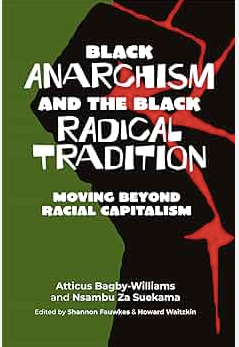Black Anarchism and the Black Radical Tradition (Book Review)
Black Anarchism and the Black Radical Tradition is a much-needed short and accessible text offering a history of Black anarchic revolutionaries and landmark documents within the Black Radical Tradition.

Black Anarchism and the Black Radical Tradition by Atticus Bagby-Williams and Nsambu Za Suekama (Daraja Press 2022)
Reviewed by Cmde. Alex
Black Anarchism and the Black Radical Tradition is a much-needed short and accessible text offering a history of Black anarchic revolutionaries and landmark documents within the Black Radical Tradition. Opening with an introduction to Black anarchism through the 2020 George Floyd/Breonna Taylor rebellions, Bagby-Williams and Za Suekama outline the contradictions between Black radicalism and North-American-European anarchism. The lack of theorization of racial capitalism in “classical” (Western) anarchist traditions has led Black radicals, and Black anarchists in particular, to develop their own analyses and organizing practices on alternative grounds.
Chapter Two outlines the shortcomings of European and North American Anarchisms through a study of racial capitalism as articulated by Cedric Robinson in Black Marxism and The Terms of Order. With the exception of a couple of recent thinkers, much of the writing on anarchism has not called out the ways in which classical anarchism emerged from “European racialized rationality” (p. 9). The authors outline four major periods and strands of European-North American anarchism: (1) individualist anarchism in the 19 th century, (2) anarcho-communism, (3) anarcho-pacifism and subcultural anarchism, and (4) contemporary (post-1980s) anarchism. Each is analyzed for its ability to understand racial capitalism and revolutionary strategy for overcoming racial
capitalism.
Black anarchism, on the other hand, “has a theoretical trajectory that is separate from prior anarchist traditions, although some Black anarchist theorists have drawn from these earlier traditions.” (p. 19) The authors identify two waves of Black anarchism. The first wave (1965-2000) includes Martin Sostre, Lorenzo Kom’Boa Ervin, Kuwasi Balagoon, and Ashanti Alston, and the second wave (2000-present) includes Zoé Samudzi, William Anderson, and the Afrofuturist Abolitionists of the Americas. While Alston serves as a mediator between these two waves of Black anarchism, what distinguishes the second wave from the first is the foregrounding of Black feminism, abolition, disability justice, and queer and trans Black struggles. Critical texts analyzed from the second wave are As Black as Resistance and The Anarkata Statement. While both texts appeared in 2018, and both address issues within the first wave of Black anarchism, they are coming from different theoretical trajectories. As Black as Resistance foregrounds the continuities of anarchism and abolitionist feminism, offering an analysis of Blackness as anarchic in-itself through its exclusion from the nation-state. While The Anarkata Statement also shows the continuity of abolition and Black feminism, it does so within a specifically Pan-African framework, analyzing trans-misogynoir, the link between queer liberation and the end of colonialism, while it also de-links disability justice from the state.
At only 50 pages of text, this book covers a lot of ground rarely explained in such a clear and concise way. It is an excellent point of entry for studying Black Anarchism and the reference section at the end is useful for readers who want to go deeper into any of the texts and topics mentioned in the book. Get a copy for all your comrades!
(Author's Note: it should be noted that the term “Anarkata” is derived from the revaluation of a slur, designating the descendants of enslaved West Africans, and should only be used by Black people.)
